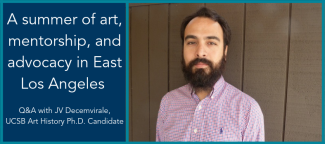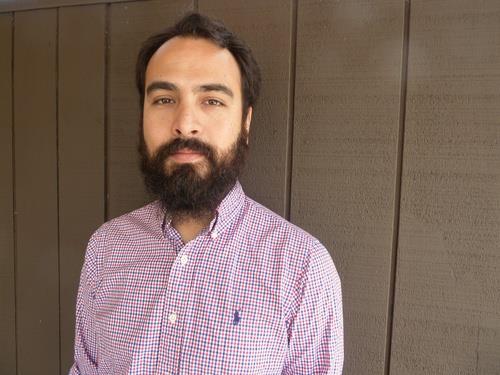Top Stories
In this Q&A, UCSB art history scholar John Vincent (JV) Decemvirale talks about his research and his summer spent combining mentorship and advocacy as Juan Manuel Silverio's advisor on Hacer, Deshacer, y Rehacer, an insightful exhibition and panel discussion featuring paintings, drawings and other art experiences showcasing works from the Self Help Graphics & Art community arts center.

 This summer, UCSB art history scholar John Vincent Decemvirale combined mentorship and advocacy for the local Los Angeles arts scene. In July, he gave a talk entitled "Recent Research on Sister Karen Boccalero, Carlos Bueno and Antonio Iba~ez," which was followed by a panel with prominent Chicano artists and collectors about the artist trio.
This summer, UCSB art history scholar John Vincent Decemvirale combined mentorship and advocacy for the local Los Angeles arts scene. In July, he gave a talk entitled "Recent Research on Sister Karen Boccalero, Carlos Bueno and Antonio Iba~ez," which was followed by a panel with prominent Chicano artists and collectors about the artist trio.
Decemvirale, a sixth-year Ph.D. candidate in contemporary Art History with a minor in Black Studies at UCSB, has been researching the foundations of the Self Help Graphics & Art (SHG) community arts center in East Los Angeles, with a focus on SHG co-founders (Sister Karen, Bueno and Iba~ez) over the past year. SHG âwas founded in the early 1970s to establish a cultural arts center promoting local artists and socially-engaged artistic practices that focused on social justice for Chicanxs.
Decemvirale also served as mentor and advisor to UCSB undergraduate student Juan Manuel Silverio who curated Hacer, Deshacer, y Rehacer, an insightful exhibition featuring prints, paintings, and drawings showcasing works from the SHG community. Silverio, a fourth-year CCS undergraduate student focusing on art and Chicano/a Studies at UCSB, spent six weeks under Decemvirale's guidance to create an exhibit to spur intergenerational conversations about the body, the barrio, queerness and the city. As the 2018 SHG Young Curator, Silverio was inspired by the story of Bueno and Iba~ez, a queer immigrant couple who played a crucial role in establishing the center.
In this GradPost Q&A, we caught up withâ Decemvirale to find out more about his experience as a mentor and presenter at the SHG.
Tell us about your talk in July on "Recent Research on Sister Karen Boccalero, Carlos Bueno and Antonio Iba~ez." What was the response of the audience to this talk? What sort of impact did you want to make on your audience?
I gave a presentation in July 2018 on the co-founders of Self Help Graphics â& Art: Sister Karen Boccalero, Carlos Bueno and Antonio Iba~ez. This was followed by a panel discussion that I led with the artists Willie Herron and Milton Antonio Jurado, as well as collector Ricardo Munoz. The idea for the event originated in a conversation with (then) Self Help Director Joel Garcia when I was requesting permission to access the SHG archive. I asked if there was anything I could do with my research for the organization, and he asked if I could share what I found in a public format. Over the course of the year, I conducted in-depth research on the cofounders and their lives as artists.
Aside from working with the SHG materials in LA and at UC Santa Barbara, I traveled to both Mexico and Northern California to review materials and artworks, as well as to speak with those who knew Sister Karen, Carlos and Antonioâ; I was very eager to share what I had found. Presenting at Self Help was different than presenting at an academic conference. For example, I referenced a story told by the artist Peter Tovar and the audience let me know that Mr. Tovar was in the audience. This type of responsiveness from the audience, as well as a high degree of scrutiny, provided unique opportunities for feedback and fact-checking, both during and after the event.
I think the panel discussion was quite successful. I intended to frame the discussion to function as a continuation of my research, but in the format of a public discussion. This allowed me to ask the panelists questions about their relationships with the co-founding artists and what they remembered about their working practices, as well as the early Self Help space. The panelists were very generous and their recollections brought to light connections which had not previously been known or correctly understood, such as the relationship between Carlos Bueno and the internationally-recognized musician and artist Willie Herron. This format provided opportunities for digging up biographical details and spatial recollections about Self Help.
The panelists brought posters, artworks and photographs related to the artists that we placed on long tables for viewing. Some members of the audience even brought their own materials related to the artists we were discussing. My intention with the event was to share what I had learned in my research and generate new material and questions. I wanted to emphasize the really exceptional artistic collaboration between Boccalero, Bueno and Iba~ez to say that the model they created for cultural work and a socially-engaged artistic practice was still very relevant for younger artists and cultural workers, particularly in East LA.
What drew you to your mentorship of Juan Silverio? In your opinion, what are the factors that make for an effective (and impactful) mentorship?
Because I had been working with Self Help's archive, then Co-Director Betty Avila asked if I would be interested in participating in their Young Curator Program as a mentor. The program is designed to introduce a younger generation of Latinxs to the complexities of curating an exhibition. Curatorial career trajectories are often difficult to decipher and there is a major lack of people of color in the field.
Self Help's Young Curator Program works to address that by providing aspiring arts with professional hands-on experience in curating an exhibition from their collection. I agreed to participate and was very happy to find out I was paired with Juan Silverioâ. Juan is a UCSB undergraduate student majoring in Studio Art and we had met previously in Special Collections when I was working in the Self Help archive.
A career in the arts is full of all sorts of hidden obstacles and unexpected trajectories, so I thought it was important to share as much as I knew about the field of contemporary art with Juan. I hope I was a useful mentor to him. I tried to create the sort of experience that I would have wanted when I was Juan's age. That translated itself not just into giving advice on how to negotiate the field, but also into an effort to introduce Juan to "veterano" artists who were part of the Chicano Movement. I wanted him to not only curate a show of art objects, but to get a deep sense of what it was like to be an artist during the 1970s, and to determine from there which artistic practices he found resonant.
Talk to us about "Hacer, Deshacer, Rehacer" -- what did this exhibition focus on? How do you think this exhibit was received by the community?
Hacer, Deshacer y Rehacer originated in Self Help's archive and collection. As I said, I had been working with this archive extensively myself, and since I found it to be such a rich resource, Juan and I spent many days looking through the numerous artworks and posters that Self Help has in its collection. Surveying this material and talking to artists who were active in the 1970s, Juan began to make connections between contemporary Latinx artists and those of an older generation. He subsequently found themes that spanned generations, such as: barrio landscapes, visions of Los Angeles, and of course, the Latinx body. I believe the exhibition was pretty well received. Juan included the work of Carlos Bueno in the show, one of the organization's co-founders. I don't believe Bueno's work has previously been shown at Self Help - so âJuan was very sensitive in addressing certain histories, as well as spotlighting younger Latinx artists.
What do you feel was the biggest impact of this experience on you as a scholar?
I am interested in how scholarship can serve a more general public. The lecture, panel and mentorship program provided opportunities for me to get my research out to a larger audience. It was a fantastic opportunity for me because Self Help's audience are the ideal readers/listeners for my work.
What are your plans for this upcoming school year? What do you hope to accomplish?
This upcoming year I will be the Smithsonian American Art Museum's Predoctoral Fellow of Latinx Art. During my fellowship year I will continue writing my dissertation and will begin in-depth research in the Archives of American Art for materials related to Black and Latino arts organizing and arts activism in Los Angeles. In short: I will continue researching and writing my dissertation, as well as sharing my work with as many people as possible, including new peers and friends.